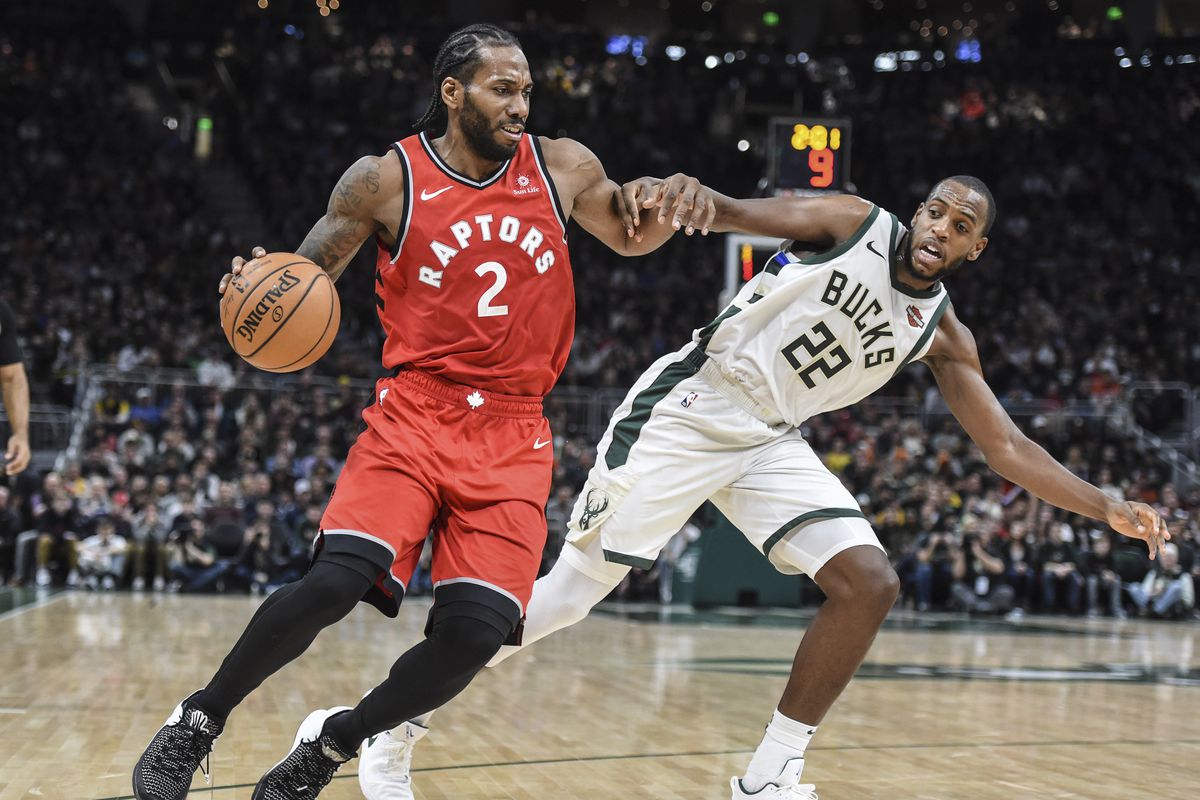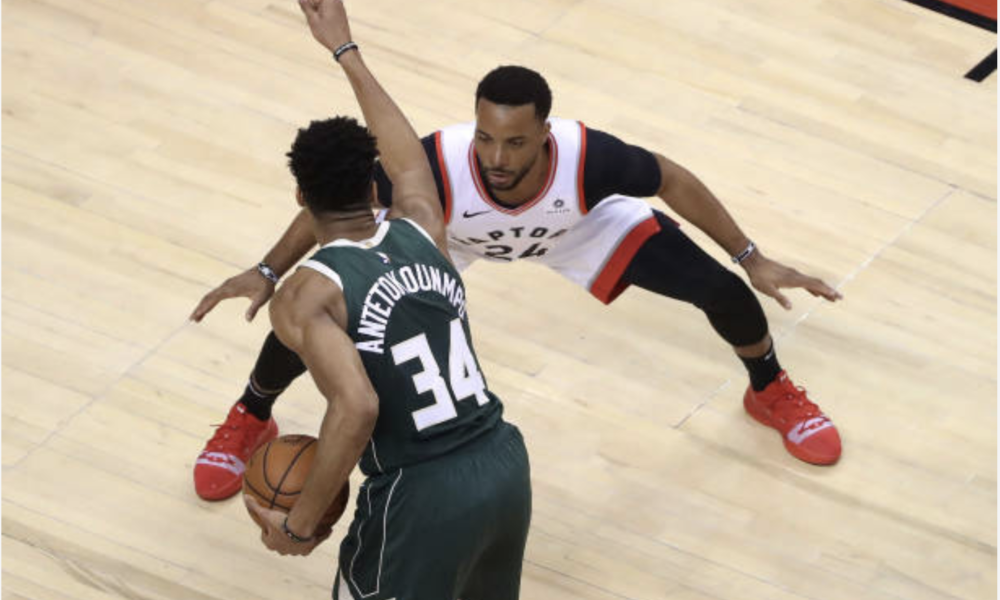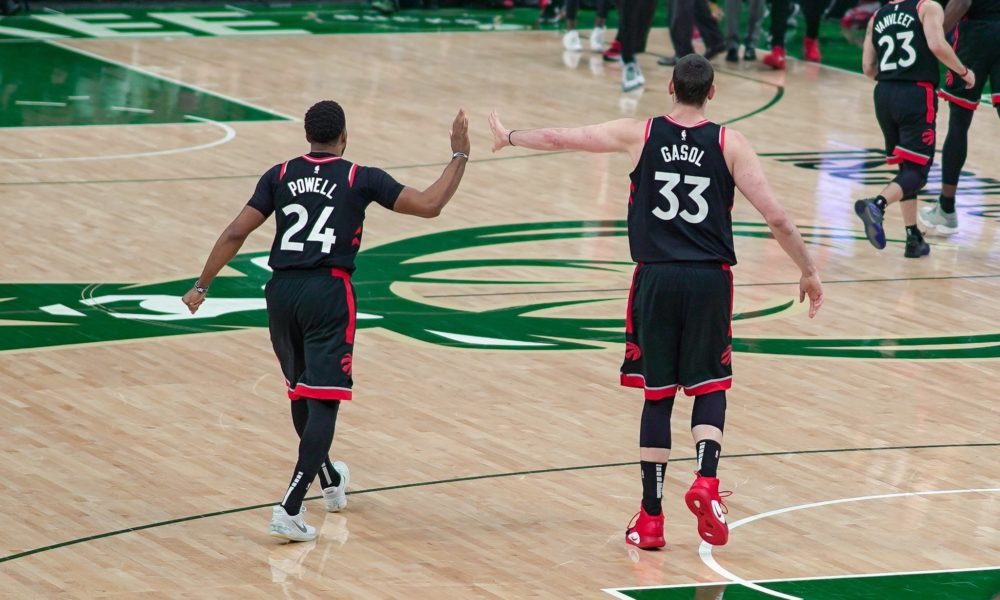The Toronto Raptors grueling double overtime on Sunday showed us a lot of things. It showed that Marc Gasol was actually capable of not only playing, but thriving, in this series. It showed that there is some life hidden in the bench in the form of Norman Powell. And, for those that have not been paying attention for the past eighth months, it showed that Kawhi Leonard can be the best player on the floor at any given moment.
It also showed us that this series is not doomed. Momentum could swing firmly in Toronto’s direction after tonight’s proceedings. Here’s why.
Key statistics
The Milwaukee Bucks have relied on three core offensive elements every game to lead the Raptors in this series: points in the paint, fast break points, and offensive rebounding. Two of those were to be expected, the Bucks were near the top of the league in scoring in transition and inside throughout the regular season and playoffs. The added commitment to crashing the offensive glass was an unexpected maneuver that has caught Toronto off-guard. Here’s how the teams have fared in each game so far:

With this three game trend in mind — small, I know — it stands to reason that Milwaukee will maintain an advantage in at least two of these departments. (The Raptors threw a few more bodies on the offensive glass in game three and may shrink that discrepancy). It is near impossible to have Giannis Antetokounmpo and play the style that the Bucks do and not beat opponents in those categories. They have outscored Toronto in transition by at least 10 points in every game thus far and are maintaining a consistent source of points near the rim. This is who the Bucks have been all season.
Despite these drastic advantages, Milwaukee couldn’t blow out the Raptors in games one or three. One huge factor has been their ineffectiveness in the half-court. During the regular season the Bucks averaged 1.09 points per possession in half-court scenarios, but Toronto has smothered them to a horrific 0.79 points per possession in the series so far. Once the game slows down, it becomes a rockfight.
Entering the playoffs it seemed that the Raptors would flourish in an open, flowing game. It also looked like Philadelphia and Orlando had limited them by instigating ugly, physical games, but those encounters may have now actually given Toronto the necessary experience required to dismantle the Bucks. On the back of Kawhi Leonard, the Raptors are scoring 1.07 points per possession in the half-court against Milwaukee — not a picture of efficiency, but far better than their opponents. Conversely, Toronto’s half-court defence has been ridiculous, the versatility and abrasiveness they play with has held playoff opponents to a measly 46.2 effective field goal percentage. If the Bucks fail to maintain their incredible efficiency in transition then they must step up against a defence that rattled them on Sunday.
The Raptors have proven each round that they can win ugly. But can the Bucks?
Bricking from deep
Another massive factor preventing the Bucks from pouring it on against Toronto has been their three-point shooting woes. Conventional wisdom envisioned Milwaukee as the the embodiment of modern NBA analytics — a rim-running, deep shooting squad that plays the efficiency of those percentages to their favour. Yet it hasn’t borne fruit in this series. Could it be small sample size? Maybe. Could it be because of the Raptors defence? Probably.
Milwaukee are shooting 35 per cent on wide open threes in playoffs, which NBA.com defines as a shot with the nearest defender six feet or more away, and 31.3 per cent on the series. In the regular season they were fourth worst in the league at nailing wide open looks from deep at just 36.3 per cent. So yes, there is a slight regression, but it is not otherworldly like the Raptors plummeting outside shot during the Philadelphia series. Milwaukee may launch the second most threes in the league, but they don’t truly possess dead-eye shooters, outside of Malcolm Brogdon and Khris Middleton. They barrage opponents with quantity over quality.
Another key statistic about the Bucks three-point shooting is that they are far more comfortable shooting wide-open looks. Well, no duh, everyone would rather an unopposed look at the rim. But despite shooting the second most threes during the regular season, they shot only 2.6 attempts with a defender within four feet of the shooter, 21st in the league. They also weren’t efficient in these situations — they ranked 19th at 28.4 per cent. Now, these numbers are also a testament to how good Antetokounmpo is at providing open looks for shooters, but those same looks aren’t emerging at the same rate against Toronto’s hyper-active defence. Toronto has helped on Antetokounmpo and recovered at such an incredible rate that the Bucks are struggling to generate wide open shots. As a result, the Bucks have nearly doubled their number of contested threes (defender 2-4 feet away) against Toronto to 4.7 attempts and are only hitting at a 14.7 per cent rate. The Bucks will always shoot threes, but the Raptors are forcing them to shoot far tougher looks. Their efficiency has subsequently fallen off of a cliff.
The only reason the Bucks have managed to salvage their outside shooting from completely imploding has been due to their triples in transition. They have launched 20.2 per cent of their threes before the shot clock reaches 15 seconds, and are hitting those looks at a 39.8 per cent rate. That is a fat number and is keeping Milwaukee afloat as they shoot 21.1 per cent in all of their other attempts. Ooph. During the regular season the Bucks shot a similar amount in transition, but only averaged 36.4 per cent in those situations. So, during this series the Bucks are actually outperforming expectations with transition threes, and if this efficiency dips at all then they are in serious trouble considering their reliance on fastbreak scoring to avoid Toronto’s set defence.
Milwaukee has relied on transition points and inside scoring this series, while the Raptors’ hopes are hinging on the dominance of their half-court defence. The variance of the Bucks ghastly shooting from deep has been overblown; there is no certainty that they will regress to the so-called ‘mean’. It is Toronto’s defence that is forcing Milwaukee’s lesser shooters to launch from uncomfortable spots later into the shot clock. If the Raptors can maintain the otherworldly defence that they have displayed over the last month, then they should, at worst, remain in touching distance in every remaining encounter. If they clean up their defensive rebounding and Milwaukee’s outside scoring in transition suffers a momentary blip, then Toronto have a legitimate shot of reaching the Finals.
I can’t wait for game four.
GAME INFO
Tipoff: 8:30 EST | TV: TSN/TNT | MIL -2.5 (O/U 216.0)
RAPTORS UPDATES
OG Anunoby (appendectomy) is at least a week away from a return. Patrick McCaw (personal) is day-to-day.
PG: Kyle Lowry, Fred VanVleet, Jeremy Lin
SG: Danny Green, Norman Powell, Jodie Meeks
SF: Kawhi Leonard, Malcolm Miller
PF: Pascal Siakam
C: Marc Gasol, Serge Ibaka, Chris Boucher, Eric Moreland
BUCKS UPDATES
DJ Wilson (ankle) is day-to-day, Pau Gasol (foot) is out, Donte DiVincenzo (heel) is out.
PG: Eric Bledsoe, George Hill
SG: Khris Middleton, Malcolm Brogdon, Pat Connaughton, Sterling Brown
SF: Giannis Antetokounmpo, Tony Snell
PF: Nikola Mirotic, Ersan Ilyasova
C: Brook Lopez



